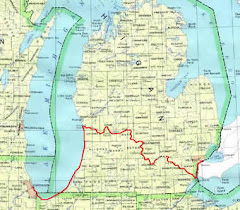When I quit the pipeline company and went to work for the State of Michigan I gave up a number of things (we were then in Fairfield, Iowa): A company car, a country club membership, a large private office, my own secretary and an unlimited expense account. We returned to Michigan by taking the train to Chicago where Dick picked us up and brought us to St Joe. Elaine's father Herman and I returned to Fairfield with Dad's pickup to bring back our earthly possessions. We rented a house in East Lansing and had to shop for a car. We bought a 1957 Plymouth 4-door with an automatic transmission and radio (Ginger colored with tail fins) for $2425. On the way home from Berrien County three days after Christmas that year a car ran a red light in Kalamazoo just as we were starting up from our signal turning green and smashed us in the right front fender Elaine and I were wearing seat belts (which I had installed) and the kids were asleep in the back and relaxed so no one was hurt.
We traded the Plymouth for a green 1962 Rambler Station Wagon (got $700 trade-in) and paid the balance of $2078 over 30 months at $79.90 per month. The Rambler was a unique car. All the seats folded down so you could sleep in it. It had a roof rack with tie-down brackets so you could carry luggage on top. We took some great trips including Yellowstone and Key West. When we bought the Plymouth Barracuda we decided to hang on to the Rambler thus we became a two-car family. Elaine drove it a lot to garage sales. Eventually it was getting pretty worn out so I took it to Watervliet and put it in the back of John's store with the idea that Jim and I could make a father-son project out of restoring it. One weekend working on it convinced us that it would not be feasible because of deterioration of the underside of the unibody (It did not have a separate frame). Quite a while later John called and said it was in the way and asked if it was OK to give it away. I agreed but later he told me he regreted it because the guy got it running again and John got to see his free car running back and forth on Main Street.
The 1966 Barracuda was a 2-door "fast back", one sporty looking automobile. Had the great Slant Six engine with a big greenhouse rear window and the back of the back seat folded down to provide a flat cargo space accessible from the rear. The color was called Racing Green. Our basset Droopy adopted the space behind the rear seat under the greenhouse as his domain and would ferociously try to attack the gas pumping guy on the other side of the glass. We would usually tell him to ignore the dog but you could tell they were always a little nervous. This was before self service. It had two accidents, the first was when Karen was driving down out of a parking ramp and a pillar came out and attacked her. The second was when I was Scoutmaster and we had 7 boys who had been ushers at an MSU football game packed in the car on the way home. A guy made an illegal left turn and smashed into the opposite fender from that the pillar smashed. The Barracuda eventually became the college car for both Karen and Jim in Ann Arbor. When Jim graduated the Barracuda limped home during a memorable trip on back roads because it conked out several times and had to be pushed.. At home I did my first and only home mechanic tune up job and got it in good running order. Jim eventually sold it for $150 and we all sadly waved goodbye as it was ignominiously towed away.
NEXT: More Jim & Elaine cars

